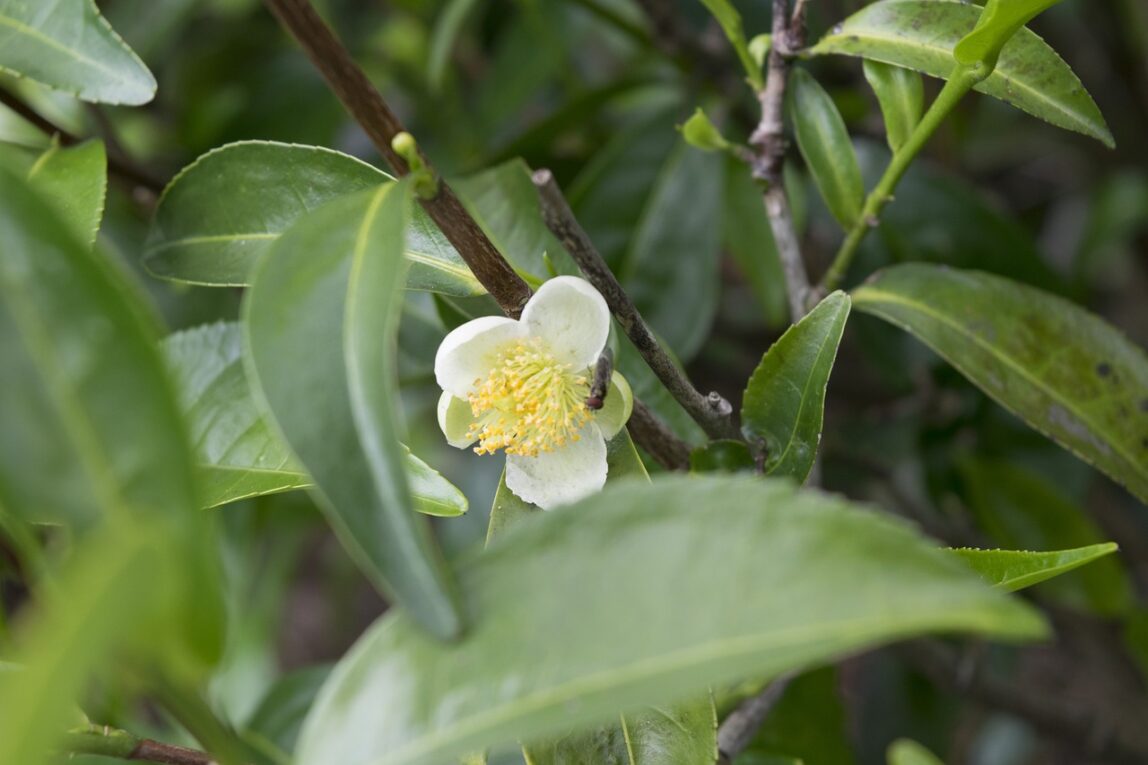Also known as Melaleuca oil, from the Melaleuca alternifolia tree. Tea tree is a species of tree native to Australia. It belongs to the Myrtaceae family and is well-known for its medicinal properties, particularly in the form of tea tree oil, which is extracted from the leaves of the tea tree.
Other Plants that are NOT Tea Tree!
Tea tree oil should NOT be confused with Tea Oil, the sweet seasoning and cooking oil from pressed seeds of the tea plant Camellia sinensis (black tea) or the Tea Oil plant Camellia oleifera.
Tea Tree Oil Production
Tea Tree Oil is produced by steam distilling the leaves of the Australian Melaleuca alternifolia. The M. alternifolia is a plant species which grows only in Australia and is native to Northern New South Wales. Harvesting the leaves from Tea Trees isn’t easy. They grow in swamps infested with snakes and insects.
Machinery won’t work under those conditions, so the leaves must be cut by hand. Workers use machetes to cut suckers off the stumps and then use a cane knife to strip the leaves from the branches. The tea trees’ growth appears to actually increase when regularly cropped. No damage is done to the trees or the surrounding ecosystem because machinery can’t be used.
The leaves are then placed in a steam distiller on racks. Oil is drawn from the leaves, floating on top of the water in collection tanks. The tea tree oil goes through a filtration process before it is poured into a container. As the oil has gained in reputation and popularity, tea tree plantations have been established where the product is grown organically.
History of Tea Tree Oil
Tea tree oil has been used for centuries by indigenous Australians for its various therapeutic benefits. Bundjalung Aborigines, who historically resided in what is now known as New South Wales, Australia, would pick the leaves from the Tea Tree plant, break them (like Aloe leaves), then they would rub the leaves over their skin to heal burns, cuts and insect bites.
They also ground the leaves into a fine paste and used it as wound dressing. Those crushed leaves were also applied over the body as an insect repellent. They taught Captain Cook how to boil the leaves to create a spiced tea, so Cook called the plant a “Tea Tree.”
Today, it is widely used in aromatherapy, skincare, and natural medicine due to its antibacterial, anti-fungal and anti-inflammatory properties.
Tea Tree Oil Active Ingredients
Tea tree oil is known for its strong, medicinal aroma and clear to pale yellow color. It contains several active compounds, including terpinen-4-ol, which is thought to be responsible for many of its therapeutic effects.
Tea Tree Oil contains more than 100 separate components. These are mostly monoterpenes, sesquiterpenes, and their alcohol forms. Tea tree oil is comprised of at least 30% terpinen-4-ol which causes most of its antimicrobial activity. This component, with specific levels of 13 others, are required for tea tree oil to meet the International Standard for Oil of Melaleuca.
Medical Use of Tea Tree Oil
Tea Tree Oil has proven effective in treating skin infections. Whether the cause of the infection is bacterial, fungal or viral, the oil works to heal it. Although it provides strong pharmaceutical medication, tea tree oil doesn’t show dangerous side effects. This pale yellow or colorless oil smells similar to eucalyptus. Although it contains more than 100 compounds, so far only 79 have been specifically identified. Some of these compounds have been found nowhere else in nature.
Tea tree oil is efficacious in various dilution in treating acne, arthritis, athletes foot, bladder infections lice, herpes lesions, warts, arthritis and gout.
Some common uses of tea tree oil include:
Tea Tree Oil as a Topical Antimicrobial
Due to the wide spectrum of viral, microbial and fungal pathogens against which tea tree oil is effective, its use is becoming widely established across the World.
In the early 1990s, scientists in the University of Western Australia’s School of Biomedical, Biomolecular and Chemical Sciences, began a study of essential Tea Tree oil. Their purpose was to investigate and verify the medicinal properties of tea tree oil, especially the oil’s antimicrobial benefits. Tea tree oil has demonstrated its wide spectrum of ability in healing bacterial, fungal and viral infections in the laboratory. These researchers have since advocated its acceptance as a topical antimicrobial agent.
The popularity of natural treatments for health problems is once again gaining momentum. In past history, before “modern” medicine, natural medicine was the only treatment available. Over the centuries native peoples found many plants which effectively treated various illnesses. Today, with the problems that have risen from overuse of antibiotics and other medications, and the side effects caused by the use of many of these, the old is becoming new again.
Tea Tree Oil for Hair Care and to Kill Nits
Tea tree oil is a popular ingredient in shampoos and conditioners, as it can help alleviate dandruff and dry scalp by moisturizing the scalp and reducing scalp irritation.
Tea tree oil is believed to have insecticidal properties that can help kill nits (lice eggs) and lice. The main active compound in tea tree oil, terpinen-4-ol, is thought to be responsible for its insect-repelling and insecticidal effects.
When applied to the scalp and hair, tea tree oil can suffocate lice by blocking their respiratory openings and disrupt their ability to cling to hair shafts. Additionally, tea tree oil is believed to interfere with the nervous system of lice, leading to paralysis and death.
Here’s how to use tea tree oil for lice and nits:
Dilute the tea tree oil: Tea tree oil should always be diluted before applying it to the scalp and hair to avoid skin irritation. Mix a few drops of tea tree oil with a carrier oil, such as coconut oil or olive oil, in a ratio of about 1 part tea tree oil to 10 parts carrier oil.
Apply the mixture to the scalp and hair: Using your fingers or a cotton ball, apply the diluted tea tree oil mixture to the scalp and hair, focusing on areas where lice and nits are present. Make sure to saturate the hair thoroughly.
Leave on for several hours or overnight: Cover the head with a shower cap or towel and leave the tea tree oil mixture on for several hours or overnight to allow it to penetrate the hair and suffocate the lice and nits.
Comb out the lice and nits: After allowing the tea tree oil mixture to sit, use a fine-toothed nit comb to comb out the lice and nits from the hair. Comb through small sections of hair from the scalp to the ends, wiping the comb on a tissue or paper towel after each pass.
Repeat as needed: Depending on the severity of the infestation, you may need to repeat the tea tree oil treatment several times over the course of a week to ensure that all lice and nits are eliminated.
Add Tea Tree Oil Daily: Adding a few drops of tea tree oil daily to kids hair can help to repel nits and stop reinfection.
It’s essential to use caution when using tea tree oil on children, as it can be irritating to the skin and eyes. Always perform a patch test on a small area of skin before applying tea tree oil to the scalp, and avoid getting it in the eyes or mouth. If irritation occurs, discontinue use immediately
Tea Tree Oil Soothes Skin
Tea tree oil is often used topically to treat acne, as it can help reduce inflammation and kill acne-causing bacteria. It is also used to soothe minor skin irritations, insect bites, and cuts.
Tea tree oil can relieve symptoms of; minor burns, chapped lips, rash from chicken pox, dandruff, dry skin and eczema. The natural oil also acts as an antiseptic to treat minor cuts and even hives and shingles. Tea tree oil may be diluted with olive oil and rubbed onto irritated or inflamed areas. It can also be added to bath water, to soothe the entire skin area.
Tea Tree Oil for Oral Health
Tea tree oil can be used as an ingredient in natural mouthwashes and toothpastes due to its antibacterial properties. It may help reduce bad breath, plaque formation and gum inflammation.
Tea Tree Oil for Aromatherapy
The fresh, invigorating scent of tea tree oil is often used in aromatherapy to promote a sense of calm and relaxation, as well as for respiratory health issues.
Tea Tree Oil for Respiratory Health
Tea Tree oil can help clear the sinuses and improve respiratory health when used in steam inhalation. A few drops of tea tree oil placed on a hot wash cloth and held over the nose to breathe through, or a few drops added to warm water, can alleviate symptoms of; head colds, earaches, asthma and bronchitis. This is due to the volatile oils entering the airways to work their antimicrobial and anti-inflammatory magic.
Other Uses of Tea Tree Oil – Household Cleaning
Household Cleaning: Tea tree oil is a natural disinfectant and can be used to clean surfaces around the home. It is effective against; bacteria, fungi and mold.
Always take care when taking herbs and Read Our Disclaimer.
Tea Tree Oil Notes / Side Effects
While tea tree oil is generally considered safe for topical use when diluted properly, it can cause skin irritation or allergic reactions in some individuals, especially those with sensitive skin. It should not be ingested or applied undiluted to the skin. Additionally, pregnant or breastfeeding women should consult with a healthcare professional before using tea tree oil.



Leave a Reply